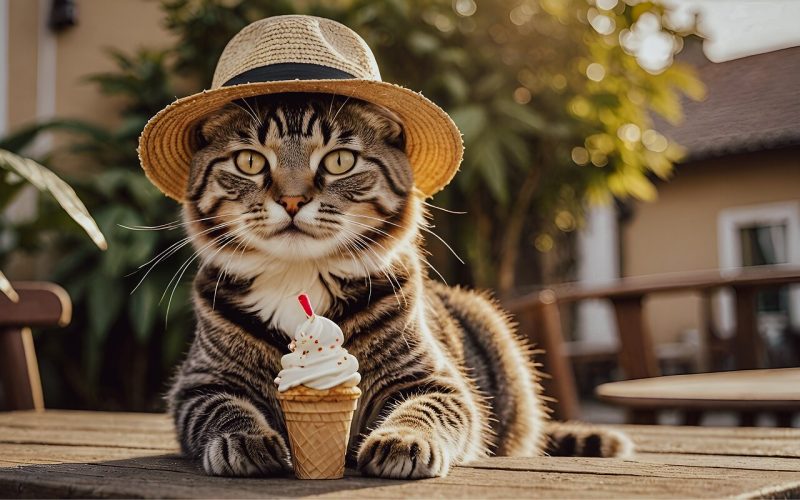
Overview of the Topic: Can Cats Eat Chocolate Ice Cream?
Feeling the heat and thinking about enjoying a refreshing ice cream? You might be tempted to let your cat have a taste, but wait a minute! Can cats eat chocolate ice cream? Although it may seem like a fun idea, this tasty summer delight is definitely off-limits for your feline friends.

Cats are curious creatures known for their discerning taste buds, but when it comes to indulging in certain human treats like chocolate ice cream, caution is advised. Understanding the implications of feeding cats chocolate ice cream is crucial for responsible pet ownership.
Risks and Concerns
Feeding cats chocolate ice cream can pose significant risks to their health. Chocolate contains substances like theobromine and caffeine, which are toxic to cats. These compounds can lead to various health issues ranging from mild discomfort to severe toxicity.
Can Cats Eat Chocolate Ice Cream? Chocolate and Its Effects on Cats
Dangers of Chocolate for Cats
Chocolate is a well-loved treat for humans but can be extremely dangerous for our feline friends. The main culprits in chocolate that make it toxic to cats are theobromine and caffeine. These substances are metabolized differently in cats compared to humans, leading to adverse effects even from small amounts of chocolate consumption.
Theobromine and Caffeine:
- Theobromine: Cats lack the necessary enzymes to break down theobromine efficiently, causing it to build up to toxic levels in their bodies. This can lead to various health issues.
- Caffeine: Another component of chocolate, caffeine, can also have detrimental effects on cats. It can cause restlessness, rapid heart rate, and even more severe symptoms in high doses.
Potential Symptoms and Health Risks
If a curious kitty manages to sneak a bite of chocolate ice cream, they may experience a range of symptoms that indicate chocolate toxicity. These can vary depending on the amount and type of chocolate ingested but may include:
- Vomiting
- Diarrhea
- Increased heart rate
- Tremors or seizures
- Hyperactivity
- Increased thirst
- Urination
In severe cases, chocolate poisoning can lead to more serious complications such as muscle rigidity, cardiac arrhythmias, and even death. It’s crucial for cat owners to be aware of these risks and take immediate action if their pet shows any signs of chocolate ingestion.
Can Cats Eat Chocolate Ice Cream?
| Feature | Cat Friendly? | Why? |
|---|---|---|
| Chocolate | No | Chocolate contains theobromine and caffeine, which are toxic to cats. These stimulants can cause vomiting, diarrhea, tremors, seizures, and even death. |
| Lactose (Milk Sugar) | No | Most cats are lactose intolerant, meaning they lack the enzyme to digest lactose. This can lead to digestive upset. |
| Sugar | No | Cats don't have a strong need for sugar and it can contribute to weight gain and dental problems. |
Ice Cream and Its Ingredients: Can Cats Eat Chocolate Ice Cream?
Analyzing Ice Cream Ingredients
Ice cream is a delightful treat enjoyed by many, but when it comes to our feline friends, caution is essential. Let’s dive into the typical ingredients found in ice cream and how they can impact a cat’s health.
Dairy:
Dairy products like milk and cream are main components of ice cream. Cats, however, are lactose intolerant, meaning their digestive systems struggle to process lactose found in dairy. Consumption of dairy can lead to gastrointestinal issues such as diarrhea and stomach discomfort in cats.
Sugar:
Sugar is another common ingredient in ice cream that can pose risks to cats. Cats are obligate carnivores, meaning their bodies are not designed to handle high levels of sugar. Introducing sugary treats like ice cream can potentially lead to weight gain, diabetes, and dental problems in cats.
Other Additives:
Ice cream often contains various additives like artificial flavors, colors, and preservatives. These additives may not sit well with a cat’s sensitive digestive system and can trigger allergic reactions or gastrointestinal upset.
Effects on Digestive System and Overall Health

When cats consume ice cream, especially chocolate ice cream, the combination of dairy, sugar, and additives can wreak havoc on their digestive system. From upset stomachs to more severe issues like pancreatitis, feeding cats ice cream can lead to a range of health problems. The lack of enzymes needed to break down lactose in dairy can cause digestive distress in cats, manifesting as bloating, gas, or diarrhea. The high sugar content in ice cream can disrupt a cat’s blood sugar levels and contribute to obesity over time, risking their overall well-being.
Alternatives to Chocolate Ice Cream for Cats
Safe and Healthy Treats for Cats
1. Catnip Treats:
- Cats adore catnip, and it can be a safe alternative to chocolate ice cream.
- Available in various forms such as treats or sprays, catnip can provide your feline friend with a delightful and safe treat.
2. Frozen Banana Slices:
- Freeze some banana slices and offer them to your cat as a sweet and healthy snack.
- Bananas are safe for cats in moderation and can satisfy their craving for something sweet.
Tips to Satisfy Your Cat’s Cravings: Can Cats Eat Chocolate Ice Cream?
1. Homemade Cat Treats:
- Create homemade treats using ingredients like cooked chicken, tuna, or pumpkin puree.
- These treats are not only safe but also tailored to your cat’s preferences.
2. Interactive Toys:
- Engage your cat with interactive toys that dispense treats when played with.
- This not only provides mental stimulation but also offers a reward without compromising their health.
Moderation is Key
While it’s tempting to share your favorite treats with your furry companion, it’s crucial to remember that cats have specific dietary requirements. By offering safe and healthy alternatives to chocolate ice cream, you can ensure that your cat enjoys delicious treats without any risks to their health.
Caring for your cat’s well-being involves making informed choices about their diet and ensuring that their nutritional needs are met. With the right treats and mindful feeding practices, you can keep your feline friend happy and healthy for years to come.
Conclusion: Can Cats Eat Chocolate Ice Cream?
Understanding the Risks of Chocolate Ice Cream for Cats
Feeding cats chocolate ice cream can pose serious risks to their health. As discussed in the previous sections, chocolate contains theobromine and caffeine, which are toxic to cats. These substances can lead to various symptoms like vomiting, diarrhea, tremors, and in severe cases, even death. Responsible pet ownership involves being aware of these dangers and ensuring that cats do not have access to chocolate or chocolate-containing products.
Prioritizing a Balanced Diet for Cats
Providing a balanced and appropriate diet is crucial for maintaining the well-being of cats. While it may be tempting to share human treats like chocolate ice cream with our feline companions, it’s essential to remember that their dietary needs differ significantly from ours. Cats require a diet that is rich in protein, with specific nutrient requirements that should be met through specially formulated cat food.
Safe Alternatives and Healthy Choices
Instead of chocolate ice cream, there are several safe and healthy alternatives that cats can enjoy. Treats like catnip, frozen banana slices, cooked chicken, or tuna can be a delightful option for your cat without posing any health risks. Additionally, interactive toys that dispense treats can provide mental stimulation and engagement, offering a rewarding experience for your furry friend while keeping them healthy.
Moderation and Careful Choices
Remember, moderation is key when it comes to treating your cat. While occasional indulgences may be acceptable, it’s crucial to prioritize their overall health and well-being. By opting for safe alternatives to chocolate ice cream and being mindful of their dietary requirements, you contribute to ensuring a long and happy life for your beloved feline companion.
Cats rely on us to make informed decisions about their nutrition and care. By staying informed about the potential risks of certain foods like chocolate ice cream andprioritizing their dietary needs, we play a vital role in their health and happiness. Understanding the specifics of what is safe and beneficial for cats to eat is an ongoing process and requires constant attention and dedication from pet owners.
In addition to choosing the right treats and foods, it’s important to maintain regular vet checkups. These visits can help ensure that your cat is not only enjoying a healthy diet but also thriving in all other aspects of their well-being. Vets can provide personalized advice based on your cat’s health, age, and activity level, tailoring recommendations to suit their individual needs.
Engaging with a community of fellow cat owners can also offer valuable insights and ideas for safe and nutritious treat options. Many online forums and social media groups dedicated to pet care share recipes, tips, and experiences that can inspire you to create enjoyable, cat-safe treats at home.
Education about the potential dangers of human foods, like chocolate, and the importance of a cat-specific diet is crucial for all cat owners. By spreading awareness and sharing knowledge, we can collectively contribute to a safer and healthier environment for all our feline friends.
Ultimately, the responsibility lies with us, the pet owners, to make informed, caring decisions about our cats’ diets.





Be the first to comment